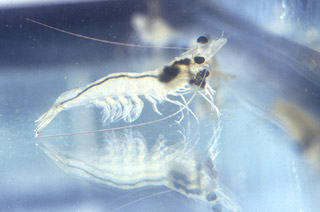Prawn

Whiteleg shrimp (Litopenaeus vannamei, formerly Penaeus vannamei), also known as Pacific white shrimp, is a variety of prawn (not shrimp) of the eastern Pacific Ocean commonly caught or farmed for food. It is the major species of farmed shrimp. Whiteleg shrimp are native to the eastern Pacific, from Sonora in Mexico to northern Peru. The main sources of whiteleg shrimp are Ecuador, Mexico and Brazil. Whiteleg shrimp sold in the U.S. market are primarily from Mexico and Ecuador. A small amount of whiteleg shrimp is now farmed in the U.S. (primarily in Texas).
In first world western nations such as Australia, Litopenaeus vannamei are sold in supermarkets, these varieties are typically labelled 'Product of China' or Vietnam. Consumers are attracted by the relative low price per Kilo. Consumers find that per kilo, the Litopenaeus vannamei retail at roughly half the price of domestically sourced prawns.
Prawns are distinguished from the superficially similar shrimp by the gill structure which is branching in prawns (hence the name, dendro="tree"; branchia="gill"), but is lamellar in shrimp. The sister taxon to Dendrobranchiata is Pleocyemata, which contains all the true shrimp, crabs, lobsters, etc.
In various forms of English, the name "prawn" is often applied to shrimp as well, generally the larger species, such as Leander serratus. In the United States, according to the 1911 Encyclopedia, the word "prawn" usually indicates a freshwater shrimp or prawn. In Middle English, the word "prawn" is recorded as prayne or prane; no cognate form can be found in any other language. It has often been connected to the Latin perna, a ham-shaped shellfish, but this is due to an old scholarly error that connected perna and parnocchie with prawne-fishes or shrimps. In fact, the Old Italian perna and pernocchia meant a shellfish that yielded nacre, or mother-of-pearl.
As used in commercial farming and fishery, the terms shrimp and prawns are generally used interchangeably. In European countries, particularly the United Kingdom, the word "prawns" is more commonly on menus than the term "shrimp", which is used more often in North America. The term "prawn" is also loosely used to describe any large shrimp, especially those that come 15 (or fewer) to the pound (also called "jumbo shrimp"). Australia and other Commonwealth countries follow this European/British use to an even greater extent, using the word "prawn" almost exclusively. (Paul Hogan's use of the phrase "I'll slip an extra shrimp on the barbie for you" in a television advertisement was intended to make what he was saying easier for his American audience to understand, and was thus a deliberate distortion of what an Australian would typically say.) In Spain, gambas al ajillo (translated to prawn pilpil) is a popular dish with both the locals and tourists. Traditionally, gambas al ajillo and other tapas are served in earthenware ramekins or cazuelas de barro in Spanish.
In first world western nations such as Australia, Litopenaeus vannamei are sold in supermarkets, these varieties are typically labelled 'Product of China' or Vietnam. Consumers are attracted by the relative low price per Kilo. Consumers find that per kilo, the Litopenaeus vannamei retail at roughly half the price of domestically sourced prawns.
Prawns are distinguished from the superficially similar shrimp by the gill structure which is branching in prawns (hence the name, dendro="tree"; branchia="gill"), but is lamellar in shrimp. The sister taxon to Dendrobranchiata is Pleocyemata, which contains all the true shrimp, crabs, lobsters, etc.
In various forms of English, the name "prawn" is often applied to shrimp as well, generally the larger species, such as Leander serratus. In the United States, according to the 1911 Encyclopedia, the word "prawn" usually indicates a freshwater shrimp or prawn. In Middle English, the word "prawn" is recorded as prayne or prane; no cognate form can be found in any other language. It has often been connected to the Latin perna, a ham-shaped shellfish, but this is due to an old scholarly error that connected perna and parnocchie with prawne-fishes or shrimps. In fact, the Old Italian perna and pernocchia meant a shellfish that yielded nacre, or mother-of-pearl.
As used in commercial farming and fishery, the terms shrimp and prawns are generally used interchangeably. In European countries, particularly the United Kingdom, the word "prawns" is more commonly on menus than the term "shrimp", which is used more often in North America. The term "prawn" is also loosely used to describe any large shrimp, especially those that come 15 (or fewer) to the pound (also called "jumbo shrimp"). Australia and other Commonwealth countries follow this European/British use to an even greater extent, using the word "prawn" almost exclusively. (Paul Hogan's use of the phrase "I'll slip an extra shrimp on the barbie for you" in a television advertisement was intended to make what he was saying easier for his American audience to understand, and was thus a deliberate distortion of what an Australian would typically say.) In Spain, gambas al ajillo (translated to prawn pilpil) is a popular dish with both the locals and tourists. Traditionally, gambas al ajillo and other tapas are served in earthenware ramekins or cazuelas de barro in Spanish.
Изображено на монетах:
Каймановы острова, 5 центов, 1972-86